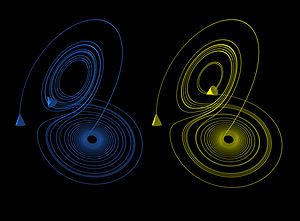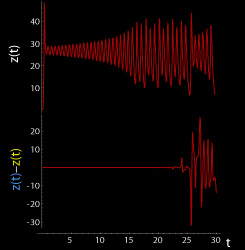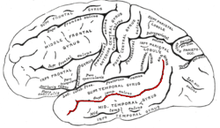Aesthetics and the philosophy of art
Aesthetics is for the artist as Ornithology is for the birds.For some, aesthetics is considered a synonym for the philosophy of art since Hegel, while others insist that there is a significant distinction between these closely related fields. In practice aesthetic judgement refers to the sensory contemplation or appreciation of an object (not necessarily an art object), while artistic judgement refers to the recognition, appreciation or criticism of art or an art work.
Philosophical aesthetics has not only to speak about art and to produce judgments about art works, but has also to give a definition of what art is. Art is an autonomous entity for philosophy, because art deals with the senses (i. e. the etymology of aesthetics) and art is as such free of any moral or political purpose. Hence, there are two different conceptions of art in aesthetics : art as knowledge or art as action, but aesthetics is neither epistemology nor ethics.[61]
What is "art"?
How best to define the term “art” is a subject of constant contention; many books and journal articles have been published arguing over even the basics of what we mean by the term “art”.[62] Theodor Adorno claimed in 1969 “It is self-evident that nothing concerning art is self-evident.”[63][64] Artists, philosophers, anthropologists, psychologists and programmers all use the notion of art in their respective fields, and give it operational definitions that vary considerably. Furthermore, it is clear that even the basic meaning of the term "art" has changed several times over the centuries, and has continued to evolve during the 20th century as well.The main recent sense of the word “art” is roughly as an abbreviation for creative art or “fine art.” Here we mean that skill is being used to express the artist’s creativity, or to engage the audience’s aesthetic sensibilities, or to draw the audience towards consideration of the “finer” things. Often, if the skill is being used in a functional object, people will consider it a craft instead of art, a suggestion which is highly disputed by many Contemporary Craft thinkers. Likewise, if the skill is being used in a commercial or industrial way it may be considered design instead of art, or contrariwise these may be defended as art forms, perhaps called applied art. Some thinkers, for instance, have argued that the difference between fine art and applied art has more to do with the actual function of the object than any clear definitional difference.[65] Art usually implies no function other than to convey or communicate an idea.
Even as late as 1912 it was normal in the West to assume that all art aims at beauty, and thus that anything that wasn't trying to be beautiful couldn't count as art. The cubists, dadaists, Stravinsky, and many later art movements struggled against this conception that beauty was central to the definition of art, with such success that, according to Danto, "Beauty had disappeared not only from the advanced art of the 1960’s but from the advanced philosophy of art of that decade as well."[63] Perhaps some notion like "expression" (in Croce’s theories) or "counter-environment" (in McLuhan’s theory) can replace the previous role of beauty. Brian Massumi brought back "beauty" into consideration together with "expression".[66] Another view, as important to the philosophy of art as "beauty," is that of the "sublime," elaborated upon in the twentieth century by the postmodern philosopher Jean-François Lyotard. A further approach, elaborated by André Malraux in works such as The Voices of Silence, is that art is fundamentally a response to a metaphysical question ('Art', he writes, 'is an 'anti-destiny'). Malraux argues that, while art has sometimes been oriented towards beauty and the sublime (principally in post-Renaissance European art) these qualities, as the wider history of art demonstrates, are by no means essential to it.[67]
Perhaps (as in Kennick's theory) no definition of art is possible anymore. Perhaps art should be thought of as a cluster of related concepts in a Wittgensteinian fashion (as in Weitz or Beuys). Another approach is to say that “art” is basically a sociological category, that whatever art schools and museums and artists define as art is considered art regardless of formal definitions. This "institutional definition of art" (see also Institutional Critique) has been championed by George Dickie. Most people did not consider the depiction of a Brillo Box or a store-bought urinal to be art until Andy Warhol and Marcel Duchamp (respectively) placed them in the context of art (i.e., the art gallery), which then provided the association of these objects with the associations that define art.
Proceduralists often suggest that it is the process by which a work of art is created or viewed that makes it art, not any inherent feature of an object, or how well received it is by the institutions of the art world after its introduction to society at large. If a poet writes down several lines, intending them as a poem, the very procedure by which it is written makes it a poem. Whereas if a journalist writes exactly the same set of words, intending them as shorthand notes to help him write a longer article later, these would not be a poem. Leo Tolstoy, on the other hand, claims that what decides whether or not something is art is how it is experienced by its audience, not by the intention of its creator. Functionalists like Monroe Beardsley argue that whether or not a piece counts as art depends on what function it plays in a particular context; the same Greek vase may play a non-artistic function in one context (carrying wine), and an artistic function in another context (helping us to appreciate the beauty of the human figure). '
See also: Classificatory disputes about art
What should we judge when we judge art?
Art can be difficult at the metaphysical and ontological levels as well as at the value theory level. When we see a performance of Hamlet, how many works of art are we experiencing, and which should we judge? Perhaps there is only one relevant work of art, the whole performance, which many different people have contributed to, and which will exist briefly and then disappear. Perhaps the manuscript by Shakespeare is a distinct work of art from the play by the troupe, which is also distinct from the performance of the play by this troupe on this night, and all three can be judged, but are to be judged by different standards.Perhaps every person involved should be judged separately on his or her own merits, and each costume or line is its own work of art (with perhaps the director having the job of unifying them all). Similar problems arise for music, film, dance, and even painting. Is one to judge the painting itself, the work of the painter, or perhaps the painting in its context of presentation by the museum workers?
These problems have been made even more difficult by the rise of conceptual art since the 1960s. Warhol’s famous Brillo Boxes are nearly indistinguishable from actual Brillo boxes at the time. It would be a mistake to praise Warhol for the design of his boxes (which were designed by Steve Harvey), yet the conceptual move of exhibiting these boxes as art in a museum together with other kinds of paintings is Warhol's. Are we judging Warhol’s concept? His execution of the concept in the medium? The curator’s insight in letting Warhol display the boxes? The overall result? Our experience or interpretation of the result? Ontologically, how are we to think of the work of art? Is it a physical object? Several objects? A class of objects? A mental object? A fictional object? An abstract object? An event? Or simply an Act?
What should art be like?
Many goals have been argued for art, and aestheticians often argue that some goal or another is superior in some way. Clement Greenberg, for instance, argued in 1960 that each artistic medium should seek that which makes it unique among the possible mediums and then purify itself of anything other than expression of its own uniqueness as a form.[68] The Dadaist Tristan Tzara on the other hand saw the function of art in 1918 as the destruction of a mad social order. “We must sweep and clean. Affirm the cleanliness of the individual after the state of madness, aggressive complete madness of a world abandoned to the hands of bandits.”[69] Formal goals, creative goals, self-expression, political goals, spiritual goals, philosophical goals, and even more perceptual or aesthetic goals have all been popular pictures of what art should be like.The value of art
Tolstoy defined art (and by no coincidence also characterized its value) as the following: "Art is a human activity consisting in this, that one man consciously, by means of certain external signs, hands on to others feelings he has lived through, and that other people are infected by these feelings and also experience them.The value of art, then, is one with the value of empathy.
But to approach the question of the value of art systematically, one ought to ask: for whom? For the artist? For the audience? For society at large, and/or for individuals beyond the audience? Is the "value" of art different in each of these different contexts?
Working on the intended value of art tends to help define the relations between art and other acts. Art clearly does have spiritual goals in many contexts, but what exactly is the difference between religious art and religion per se? The truth is complex; art is both useless in a functional sense, and also the most important human activity.[citation needed]
An argument for the value of art, used in the fictional work The Hitchhikers Guide to the Galaxy, proceeds that, if some external force presenting imminent destruction of Earth asked humanity what its value was—what should humanity's response be? The argument continues that the only justification humanity could give for its continued existence would be the past creation and continued creation of things like a Shakespeare play, a Rembrandt painting or a Bach concerto. The suggestion is that these are the things of value which define humanity.[70]





 , then
, then  such that
such that
 RosalindFranklin's high-resolution X-ray diffraction images of DNA
RosalindFranklin's high-resolution X-ray diffraction images of DNA  Crickand Watson met at the Cavendish Laboratory in
Crickand Watson met at the Cavendish Laboratory in  In1993, Watson and Crick re-create a famous photograph taken
In1993, Watson and Crick re-create a famous photograph taken 


